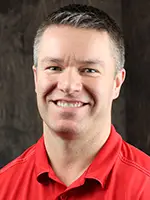
Drone technology to dial in forage inventories
 With Terry Seubert, Vita Plus IT services development coordinator, and Dr. Michelle Chang-Der Bedrosian, Vita Plus forage and dairy technical services
With Terry Seubert, Vita Plus IT services development coordinator, and Dr. Michelle Chang-Der Bedrosian, Vita Plus forage and dairy technical servicesDrone technology can help producers dial in their forage inventories and better manage their feeding programs.
Forage volume
Terry Seubert conducts drone flights for the Vita Plus forage team. He said a lot of work gets done before the drone ever takes flight. He first sets surveying equipment – like surveying crews do for construction projects – around the feed pad to get highly accurate measurements of the forage storage area. This is a key step in attaining accurate measurements.
As an example, Seubert said he recently conducted a drone flight at a farm where it appeared the bunker was situated on a relatively flat area. In reality, the base of the bunker had an 8-foot slope from the back to the front of the bunker. As such, the volume toward the front of the bunker was significantly higher than the volume toward the back.
Once the surveying base units are set to get elevation measurements, Seubert uses GPS guidance to fly the drone over the area and take hundreds of photos. Those photos are then “stitched” together and paired with the surveying data. The result is highly accurate forage volume measurements.
Seubert said a minimum of two flights is needed and, ideally, those flights should be between 30 and 40 days apart. The two flights allow the forage team to accurately measure the volume of feed used in that time period.
 Forage density and inventory projections
Forage density and inventory projections
As Dr. Michelle Chang-Der Bedrosian pointed out, farm consultants have long known the importance of forage density as it indicates how the feed was made and stored and affects dry matter (DM) loss and forage quality. For many years, taking cores from the forage face has been a gold standard in measuring forage density, but Chang-Der Bedrosian said that density can vary across the face and throughout the bunker or pile.
Although accuracy is a key goal, Chang-Der Bedrosian said safety is an even bigger priority. As bunkers and piles become taller, approaching the face becomes very dangerous. Use of drone technology keeps people safely away from the forage face.
Data management is a key aspect of accurate forge density calculations with the drone program. If a farm uses feed management software, managers can look up how many tons of feed were fed between drone flights. That amount is divided by the change in volume to give the forage density. That density can then be used to determine how many tons of feed are left in the bunker or pile. If a farm doesn’t use feed management software, the feeder(s) need to keep accurate notes of tons fed each day.
Chang Der-Bedrosian said she is focused on “effective density,” which she defines as the density of the feed that is actually fed. For example, the feeder may toss out the top few inches of feed because it is spoiled. The tonnage of that spoiled feed is not measured and, therefore, not included in the density calculations. But, because that feed will never end up in front of cows, it shouldn’t be included when making inventory projections.
Even if a farm is unable to track tons fed, Chang-Der Bedrosian said the drone program can still be used. Based on the volume measurements, inventory predictions can be made at several different densities. This at least gives producers a window of when the forage will run out.
Putting a drone to work on your farm
Chang-Der Bedrosian said the Vita Plus team continues to conduct research, evaluate data, and fine-tune the drone program to provide dairy producers with the highest accuracy possible.
Contact your Vita Plus consultant to learn more about drone technology, the Vita Plus Forage Inventory and Management Evaluation, and how these tools may be put to work on your farm.
| Category: |
Business and economics Forage Foundations Forage storage and management Soil health Technology and data management |

